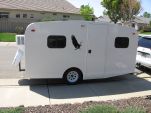Shore Power Inlet Adapter
22 posts
• Page 2 of 2 • 1, 2
Plugging a 15amp cord into a 30 amp plug isn't a great idea, But its pretty common in the RV world. There is nothing protecting the cord or the connection to the power strip in the bus.. Sure the power strip has a cheap breaker inside it. Just the cord right up to the breaker can melt.. I"m sure someone somewhere makes a 30amp to 15amp pigtail with a 15 amp breaker might just cost a little more..
- 8ball_99
- 500 Club
- Posts: 623
- Joined: Sun Mar 07, 2010 12:34 am
8ball_99 wrote:Plugging a 15amp cord into a 30 amp plug isn't a great idea, But its pretty common in the RV world. There is nothing protecting the cord or the connection to the power strip in the bus.. Sure the power strip has a cheap breaker inside it. Just the cord right up to the breaker can melt.. I"m sure someone somewhere makes a 30amp to 15amp pigtail with a 15 amp breaker might just cost a little more..
If you have a direct short in your 15 amp, #14 gauge wire entrance cable, that will cause the 30 amp supply circuit breaker to trip.
If your RV has a 15 amp circuit breaker, it does not matter that it is on the opposite end of the service entrance cable with it's 30 amp breaker, it will trip if > 15 amps happen.
If the 15 amp breaker is broken, then the 30 amp breaker will trip, when > 30 amps happens.
The point is that electricy has to have a complete path.
It does not matter where in that path you place the circuit breaker.
It can be in the campground supply panel, right after the entrance to the RV, or even after the load.
It only matters that the path is broken, if circuit breaker is tripped.
My TTT Garageable Standy Build Journal: viewtopic.php?f=50&t=40591
-

terryjones1 - Gold Donating Member
- Posts: 266
- Images: 1
- Joined: Wed Aug 25, 2010 2:09 pm
- Location: Lincoln, Ca

